火星介绍 英语ppt
火星介绍_英语ppt
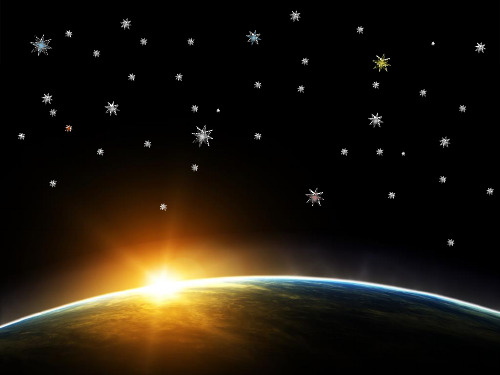
Jupiter Question 木星
Uranus 天王星 Saturn 土星 the names of the 火星
Neptune 海王星
Mercury 水星
What are
Venus planets 金星
eight
of the solar systerm?
Mars
Mars
Protect the Earth
THANKS
THANKS
Mars is the fourth planet from the Sun
in the Solar System..
Mars
Equatorial radius :3397.2km Quality:6.4219×10^23 kg
Equatorial radius :6372.8km Quality:5.98×10^24 kg
“Opportunity” Mars probe (机遇号) Time of Launch: 2003. 7. 7 Time of Landing: 2004.1.25
Mars Exploration
“Curiosity” Mars probe (好奇号)
Time of Launch: 2011. 11.26 Planned Time of Landing: 2012. 8
Mars' diameter is only about half and its mass about one-tenth the Earth's.
Mars
Spring Mars has polar ice caps and clouds in its of Mars atmosphere, seasonal weather patterns, volcanoes, canyons and other recognizable features. However, conditions on Mars vary wildly from what we know on our own planet.
火星(中英文材料)

Planet Profile星球简介Mars火星The Red Planet has a host of new robots investigating it这颗红色星球有很多新的机器人正在研究它Across the gulf of space, no other planet has fired humanity’s imagination so much as the Red Planet, and it has frequently been associated with violence, war and death. To the ancient Sumerians it was Nergal, a god of war and plague who presided over the netherworld. In Mesopotamia it was the ‘star of judgement of the fate of the d ead’. The Chinese associated it with the element fire, while for the people of the Tiwi Islands off the coast of Australia the planet was one of the four wives of the Moon Man, who followed the path of the Sun Woman through the sky –the other wives were Mercury, Jupiter and Venus. The planet was a familiar sight to the astronomers of ancient Egypt, Babylonia, Rome –where Mars was the god of war –and Greece, where Aristotle noticed that the planet vanished behind the Moon during an occultation, proving it was farther away.穿过太空湾,没有任何一颗星球能像红色星球那样激发人类的想象力,而且它经常与暴力、战争和死亡联系在一起。
《Life on Mars》PPT课件优秀课件
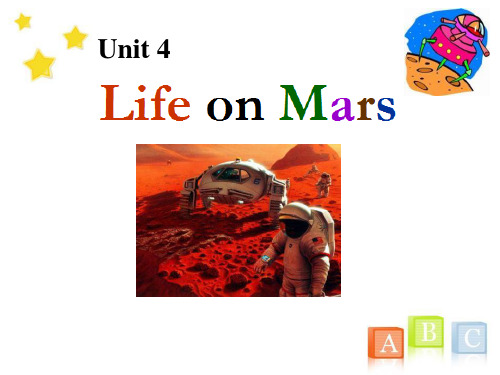
on Earth
on Mars
pollution
公开课课件优质课课件PPT优秀课件PP T免费 下载《L ife on Mars》PPT课件
no pollution
公开课课件优质课课件PPT优秀课件PP T免费 下载《L ife on Mars》PPT课件
What’s the life like on Mars?
公开课课件优质课课件PPT优秀课件PP T免费 下载《L ife on Mars》PPT课件
Unit 4
公开课课件优质课课件PPT优秀课件PP T免费 下载《L ife on Mars》PPT课件
公开课课件优质课课件PPT优秀课件PP T免费 下载《L ife on Mars》PPT课件
Words and Expressions
Where is Ma11r1s1? Solar System
公开课课件优质课课件PPT优秀课件PP T免费 下载《L ife on Mars》PPT课件
It’s more like the Earth than the other planets in solar system.
火星:太阳系八大行星之D一o y,o按u k离n太ow阳由 近而远的次序计为第四颗an,yt比hi地ng球a小bo,u公t 转周期约687天,自转周M期a约rs2?4小W时ha3t7分do。es 公转周期:约687天 it look like?
Read the conversation and answer the questions. 11..BWehcayudsoe wtheernee’esdletsoswgreavristypeocniaMl baorost.s on Mars? 2. We might need sleeping bag too. 2. What gerlsaevidtyo[wU]e(nfoerecde)t:o live on Mars?
《Life on Mars》PPT课件

Unit 4
Words and Expressions
Mars n. 火星 helmet n. 头盔 air tank n. 氧气罐 dried food n. 干粮 power pack n. 电源包 sleeping bag n. 睡袋 gravity n. 重力
Eddie and Hobo are also talking about life on Mars.
the force that attracts objects towards
33..WBehcyaudosoneewtaheneohrtaehveiesr,nteosopefearctuiaidltlryoierthdvefefogooerdctaeobtnhleast. Mars? makes things fall to the ground
44..iIWssntehodeporoenl’latuntkyinopnoowol.lnuAtMmioanyrhos.nopMesatrhsa?t there
1. I can’t get to my food. 我吃不到我的食物了。
get to 到达;开始;接触到 What time does this train get to New York? 这列火车什么时候到达纽约? How can I get to Hilton Hotel? 我要如何才能到达希尔顿饭店?
自转周期:24小时37分2I2t秒looks red. So it 行星直径:6794 千米 is also called the 质量:6.4191e20吨 Red Plae like on Mars?
on Earth
on Mars
food
pills
What’s the life like on Mars?
火星英文介绍
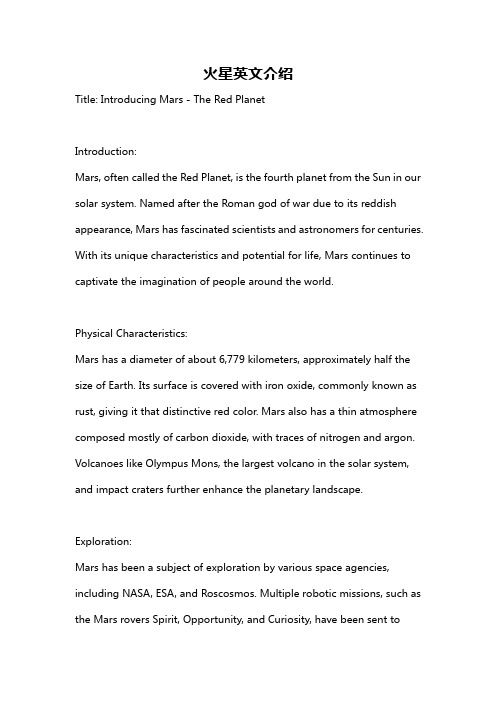
火星英文介绍Title: Introducing Mars - The Red PlanetIntroduction:Mars, often called the Red Planet, is the fourth planet from the Sun in our solar system. Named after the Roman god of war due to its reddish appearance, Mars has fascinated scientists and astronomers for centuries. With its unique characteristics and potential for life, Mars continues to captivate the imagination of people around the world.Physical Characteristics:Mars has a diameter of about 6,779 kilometers, approximately half the size of Earth. Its surface is covered with iron oxide, commonly known as rust, giving it that distinctive red color. Mars also has a thin atmosphere composed mostly of carbon dioxide, with traces of nitrogen and argon. Volcanoes like Olympus Mons, the largest volcano in the solar system, and impact craters further enhance the planetary landscape.Exploration:Mars has been a subject of exploration by various space agencies, including NASA, ESA, and Roscosmos. Multiple robotic missions, such as the Mars rovers Spirit, Opportunity, and Curiosity, have been sent toexplore the planet's surface, providing valuable data about its geology and potential for life. Additionally, the recent successful landing of NASA's Perseverance rover in February 2021 opens up new possibilities for uncovering Mars' history and signs of ancient life.Potential for Life:One of the most exciting aspects of Mars is its potential for supporting life. Although the planet's extreme cold, thin atmosphere, and lack of liquid water make it inhospitable for humans, the discovery of water ice at the polar caps and underground raises hopes for microbial life. Future missions aim to search for traces of microbial life and study the habitability of Mars in more detail, with the ultimate goal of sending humans to the planet in the future.Future Exploration:The exploration of Mars is an ongoing endeavor, with multiple planned missions in the coming years. NASA's Artemis program aims to put humans back on the Moon, as a stepping stone towards Mars colonization. Private companies like SpaceX also have ambitious plans to send humans to Mars within the next few decades. These efforts reflect the growing interest in understanding Mars' potential for life and expanding our presence in the universe.Conclusion:Mars, with its unique physical characteristics, ongoing exploration efforts, and potential for life, continues to captivate humanity. As we strive to uncover the mysteries of this captivating planet, Mars represents an exciting destination for future exploration and holds the promise of changing our understanding of our place in the universe.。
八大行星英语表达(课堂PPT)
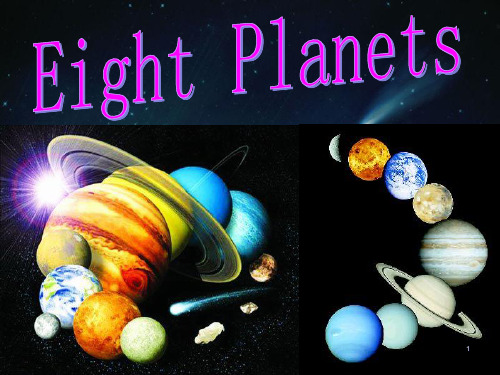
solar system
Our solar system consists of the sun, eight planets (and their moons), an asteroid belt(小行 星带), and many comets (彗星) and meteors(流星).
2
Mercury(水星)
Mercury is the planet closest to the Sun in our Solar System.
This small, rocky planet has almost no atmosphere.
its surface is similar to
the surface of our
12
天王星 (Uranus)
Uranus is the seventh planet from the sun in our solar system.
This huge, icy planet is covered with clouds and is encircled by a belt of 11 rings and 22 known moons.
7
Mars(火星)
Mars, the red planet, is the fourth planet from the sun and the most Earth-like planet in our solar system.
It is about half the size of Earth and has a dry, rocky surface and a very thin atmosphere.
17
My Very Excellent Mother Just Sent Us Nine Pizzas
火星内部英文介绍
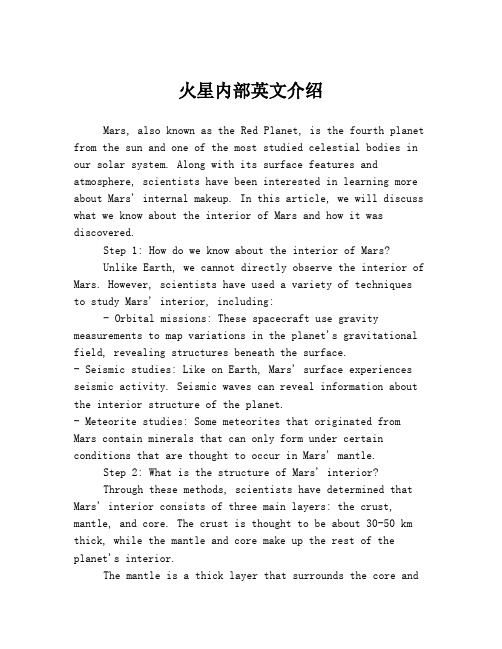
火星内部英文介绍Mars, also known as the Red Planet, is the fourth planet from the sun and one of the most studied celestial bodies in our solar system. Along with its surface features and atmosphere, scientists have been interested in learning more about Mars' internal makeup. In this article, we will discuss what we know about the interior of Mars and how it was discovered.Step 1: How do we know about the interior of Mars?Unlike Earth, we cannot directly observe the interior of Mars. However, scientists have used a variety of techniquesto study Mars' interior, including:- Orbital missions: These spacecraft use gravity measurements to map variations in the planet's gravitational field, revealing structures beneath the surface.- Seismic studies: Like on Earth, Mars' surface experiences seismic activity. Seismic waves can reveal information about the interior structure of the planet.- Meteorite studies: Some meteorites that originated from Mars contain minerals that can only form under certain conditions that are thought to occur in Mars' mantle.Step 2: What is the structure of Mars' interior?Through these methods, scientists have determined that Mars' interior consists of three main layers: the crust, mantle, and core. The crust is thought to be about 30-50 km thick, while the mantle and core make up the rest of the planet's interior.The mantle is a thick layer that surrounds the core andis made up of hot, partially molten rock. The core, which is thought to be about 1,800 km in diameter, is believed to be made up of iron and nickel.Step 3: What do we know about Mars' core?While scientists are still learning about the details of Mars' core, they believe that it is partly molten and that it does not have a strong magnetic field like Earth's core. This lack of a magnetic field may be due in part to the fact that Mars' core is cooling and solidifying, which would prevent the formation of a magnetic field.Step 4: What does Mars' interior tell us about its history?By studying the interior of Mars, scientists hope to learn more about the planet's history and how it has evolved over time. For example, the size and composition of Mars' core may provide insights into how the planet formed and how it has changed since then.Additionally, understanding the interior structure of Mars may help us better understand the planet's surface features and why they look the way they do. For example, by studying Mars' mantle, scientists may be able to explain why some areas of the planet have higher elevation and thicker crusts than others.Conclusion:While we still have much to learn about the interior of Mars, studying this aspect of the planet is crucial to understanding its evolution and place in the solar system. As technology continues to improve, we can look forward to exciting new discoveries about the Red Planet's inner workings.。
八大行星英语演讲ppt(便宜正宗有价值)
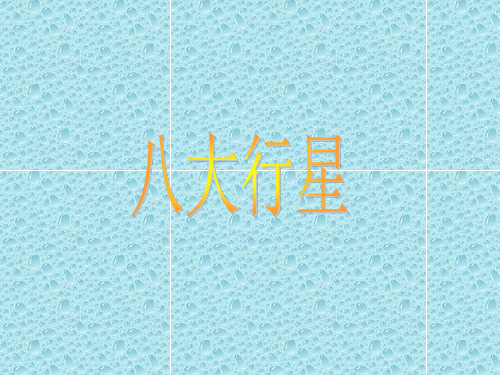
火星
火星是太阳系由内往外数的第 四颗行星,属于类地行星,直径为 地球的一半,自转轴倾角、自转周 期相近,公转一周则花两倍时间。 在西方称为战神玛尔斯,中国则称 为“荧惑”。橘红色外表是因为地 表的赤铁矿(氧化铁)。火星基本 上是沙漠行星,地表沙丘、砾石遍 布,没有稳定的液态水体。二氧化 碳为主的大气既稀薄又寒冷,沙尘 悬浮其中,每年常有尘暴发生。火 星两极皆有水冰与干冰组成的极冠, 会随着季节消长。
土星
土星,为太阳系八大行星之一,至太 阳距离(由近到远)位于第六、体积则仅 次于木星。并与木星、天王星及海王星同 属气体(类木)巨星。古代中国亦称之镇 星或填星。
天王星
天王星是太阳向外的第七颗行 星,在太阳系的体积是第三大(比 海王星大),质量排名第四(比海 王星轻)。他的名称来自古希腊神 话中的天空之神乌拉诺斯 (Οὐρανός),是克洛诺斯(农 神)的父亲,宙斯(朱比特)的祖 父。天王星是第一颗在现代发现的 行星,虽然它的光度与五颗传统行 星一样,亮度是肉眼可见的,但由 于较为黯淡而未被古代的观测者发 现。威廉· 赫歇耳爵士在1781年3月 13日宣布他的发现,在太阳系的现 代史上首度扩展了已知的界限。这 也是第一颗使用望远镜发现的行星。
天王星是第一颗在现代发现的行星虽然它的光度与五颗传统行星一样亮度是肉眼可见的但由于较为黯淡而未被古代的观测者发现
各大行星
一、水星 二、金星 三、地球 四、火星 五、木星 六、土星 七、天王星 八、海王星
水星
水星 (Mercury ),中国古代称为辰星。 是太阳系中的类地行星,其主要由石质和 铁质构成,密度较高。自转周期很长为 58.65天,自转方向和公转方向相同,水星 在88个地球日里就能绕太阳一周,平均速度 47.89千米,是太阳系中运动最快的行星。无 卫星环绕。它是八大行星中是最小的行星, 也是离太阳最近的行星。
《Life on Mars》PPT课件

33..WBehcyaudosoneewtaheneohrtaehveiesr,nteosopefearctuiaidltlryoierthdvefefogooerdctaeobtnhleast. Mars? makes things fall to the ground
Homework
1. Learn the new words and expressions by heart. 2. Preview the article:
Moving to Mars
我们要以今天为坐标,畅想未来几年后的自己。 只要还有明天,今天就永远是起跑线。 相信就是强大,怀疑只会抑制能力,而信仰就是力量。
Unit 4
Words and Expressions
Mars n. 火星 helmet n. 头盔 air tank n. 氧气罐 dried food n. 干粮 power pack n. 电源包 sleeping bag n. 睡袋 gravity n. 重力
Eddie and Hobo are also talking about life on Mars.
Where is Ma11r1s1? Solar System
It’s more like the Earth than the other planets in solar system.
火星:太阳系八大行星之D一o y,o按u k离n太ow阳由 近而远的次序计为第四颗an,yt比hi地ng球a小bo,u公t 转周期约687天,自转周M期a约rs2?4小W时ha3t7分do。es 公转周期:约687天 it look like?
《Life on Mars》PPT课件
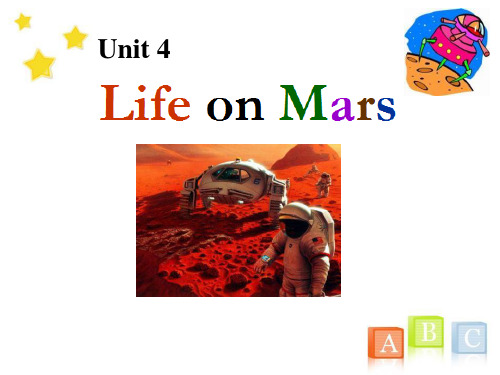
Homework
1. Learn the new words and expressions by heart. 2. Preview the article:
Moving to Mars
成功是一种观念,成功是一种思想,成功是一种习惯,成功是一种心态。 伟大的事业,需要决心,能力,组织和责任感。 ——易卜生 为中华之崛起而读书。 征服自己,就能征服一切。 只会幻想而不行动的人,永远也体会不到收获果实时的喜悦。 学校的目标应当是培养有独立行动和独立思考的个人,不过他们要把为社会服务看作是自己人生的最高目标。 对于人来说,白癜风康复报告问心无愧是最舒服的枕头重在实干。 我为你今天的表现感到骄傲。 自以为拥有财富的人,其实是被财富所拥有。
2. We’d probably need to wear special boots. 我们可能需要穿特殊的靴子。 wear 穿着,戴着;面露;留着(胡须等)
When we drove through the gates, she wore a look of amazement. 我们驶过大门时,她流露出惊讶的神情。
What would it be like to live on Mars. Work in pairs and discuss with your partner. Use the conversation on page 51 as a model.
For example:
RYWeigshh,abtt,uwatnotduhlewdreit be wlikoueltdonblieveendon spMpoealclruisat?ilobnoonts,Mtoaor.s.
W I aeglrle, ethweirteh’syoleus.sAnd
《Life on Mars》PPT课件【英语课件】
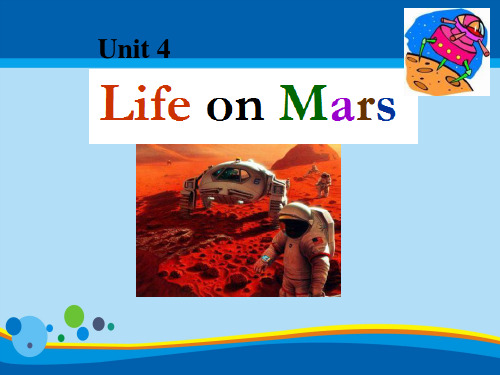
space helmet special boots
computer
tent
sleeping bag
Read the conversation and answer the questions.
11..BWehcayudsoe wtheernee’esdletsoswgreavristypeocniaMl baorost.s on Mars? 2. We might need sleeping bag too. 2. What gerlsaevidtyo[wU]e(nfoerecde)t:o live on Mars?
2. We’d probably need to wear special boots. 我们可能需要穿特殊的靴子。 wear 穿着,戴着;面露;留着(胡须等)
When we drove through the gates, she wore a look of amazement. 我们驶过大门时,她流露出惊讶的神情。
W I aeglrle, ethweirteh’syoleus.sAnd
owwddWnxrrieoiicyeeeuweglddll.oed,ffnuootnlhooodeddaneh.dtiaMIs’vsstnepahqoriattnuoscqk.ieeutWaeittee
hdelimcieotusa.nd air tank.
She wears very little makeup.
她基本上不化妆。 When she's working she wears her hair in a ponytail.
Role-play
1W. Reo’llel psleaey iwn hgriocuhpgs;roup 2. Roledopleasy tinhefrobnetsot.f the class
- 1、下载文档前请自行甄别文档内容的完整性,平台不提供额外的编辑、内容补充、找答案等附加服务。
- 2、"仅部分预览"的文档,不可在线预览部分如存在完整性等问题,可反馈申请退款(可完整预览的文档不适用该条件!)。
- 3、如文档侵犯您的权益,请联系客服反馈,我们会尽快为您处理(人工客服工作时间:9:00-18:30)。
Protect the Earth源自THANKSTHANKS
Mars
Equatorial radius :3397.2km Quality:6.4219×10^23 kg
Equatorial radius :6372.8km Quality:5.98×10^24 kg
Mars' diameter is only about half and its mass about one-tenth the Earth's.
“Opportunity” Mars probe (机遇号) Time of Launch: 2003. 7. 7 Time of Landing: 2004.1.25
Mars Exploration
“Curiosity” Mars probe (好奇号)
Time of Launch: 2011. 11.26 Planned Time of Landing: 2012. 8
XXX 201X.X.X
Earth 地球
Jupiter Question 木星
Uranus 天王星 Saturn Mars 土星 the names of the 火星
Neptune 海王星
Mercury 水星
What are
Venus planets 金星
eight
of the solar systerm?
Life on Mars?
Colour view of crater with water ice
Mars Exploration
NASA:美国宇航局
“Spirit” Mars probe (勇气号) Time of Launch: 2003. 6.10 Time of Landing: 2004. 1. 4
Volcano on Mars
Life on Mars?
Pictures of channels probably carved by running water on Mars
Among our discoveries about Mars, one stands
out above all others: the possible presence of liquid water on Mars, either in its ancient past or preserved in the subsurface today. Water is key because almost everywhere we find water on Earth, we find life.
Mars
Spring Mars has polar ice caps and clouds in its of Mars atmosphere, seasonal weather patterns, volcanoes, canyons and other recognizable features. However, conditions on Mars vary wildly from what we know on our own planet.
Mars
Mars
Mars is the fourth planet from the Sun
in the Solar System. Mars is named for
the Roman god of war, presumably
because of its distinctly reddish color.
